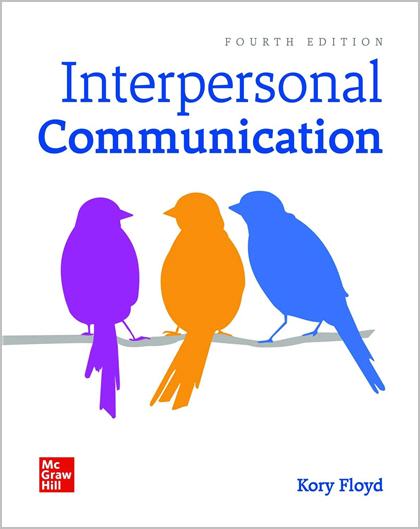Description
Interpersonal Communication 4th Edition by Kory Floyd, ISBN-13: 978-1260007077
[PDF eBook eTextbook] – Available Instantly
- Publisher: McGraw Hill; 4th edition (January 11, 2023)
- Language: English
- 480 pages
- ISBN-10: 1260007073
- ISBN-13: 978-1260007077
Drawing upon his own highly contemporary research on affection in relationships, and on the interplay of communication, physiology, and health, Kory Floyd has crafted a down-to-earth, 21st Century perspective on the complex and nuanced enterprise that is interpersonal communication. To reflect the experiences and expectations of today’s multidimensional student population, Interpersonal Communication: The Whole Story addresses a broader range of interpersonal communication contexts than any other book of its kind–by incorporating “dark side” IPC throughout the text and by including deeply diverse populations in its research-based and everyday examples. Floyd describes this as telling “The Whole Story,” (if not a more accurate one) rather than telling just the part that relates to mainstream populations. Throughout the text, Floyd encourages students to go beyond their “intuitive” notions about interpersonal communication, and helps them see the value in investigating relational processes systematically.
Table of Contents:
Table of Contents and Preface
Cover
Title Page
Copyright
Dedication
About the Author
Brief Contents
Contents
Boxes
Preface
Instructor’s Guide to Connect for Interpersonal Communication
A Personalized and Adaptive Learning Experience with SmartBook 2.0.
Interpersonal Communication Bridges Theory and Practice
Interpersonal Communication Emphasizes Critical Contexts: Technology, Gender, Culture, and Relationships
Interpersonal Communication Promotes Competence
Instructor Reports
Video Capture Powered by GoReact™
Classroom Preparation Tools
Support to Ensure Success
Content
Contributors
Acknowledgments
Chapter 1: About Communication
Chapter 1 Introduction
A Close Relationship, at a Distance
1. Why We Communicate
Communication Meets Physical Needs
Communication Meets Relational Needs
Communication Fills Identity Needs
Communication Meets Spiritual Needs
Communication Serves Instrumental Needs
2. The Nature of Communication
Three Models of Human Communication
Six Characteristics of Communication
Dispelling Some Communication Myths
3. How We Communicate Interpersonally
Characteristics of Interpersonal Communication
Why Interpersonal Communication Matters
4. Building Your Communication Competence
What Communicating Competently Involves
Characteristics of Competent Communicators
Competent Online Communication
Master the Chapter
Key Terms
Chapter 2: Culture and Gender
Chapter 2 Introduction
A Triumph of Cultural Cooperation
1. Understanding Culture and Communication
Defining Culture
The Components of Culture
Cultures and Co-Cultures
Social Media as a Co-Culture
Communicating with Cultural Awareness
2. How Culture Affects Communication
Individualism and Collectivism
Low- and High-Context Cultures
Low- and High-Power-Distance Cultures
Masculine and Feminine Cultures
Monochronic and Polychronic Cultures
Uncertainty Avoidance
Cultural Communication Codes
Cultural Universals
3. Understanding Gender and Communication
Sex
Gender Identity
Gender Roles
Sexual Orientation
Some Explanations for Gendered Communication
4. How Gender Affects Communication
Gender and Verbal Communication
Gender and Nonverbal Communication
Master the Chapter
Key Terms
Chapter 3: Communication and the Self
Chapter 3 Introduction
Living Multiple Lives
1. Understanding the Self: Self-Concept
What Is a Self-Concept?
How a Self-Concept Develops
Awareness and Management of the Self-Concept
2. Valuing the Self: Self-Esteem
Benefits and Drawbacks of Self-Esteem
Culture, Gender, and Self-Esteem
The Self and Interpersonal Needs
3. Presenting the Self: Image Management
Principles of Image Management
Managing Face Needs
4. Communicating the Self: Self-Disclosure
Principles of Self-Disclosure
Benefits of Self-Disclosure
Risks of Self-Disclosure
Challenges and Risks of Disclosing Online
Master the Chapter
Key Terms
Chapter 4: Interpersonal Perception
Chapter 4 Introduction
Making Sense of Our Social World
1. The Process of Perception
Interpersonal Perception Defined
Three Stages of the Perception Process
Influences on Perceptual Accuracy
Forming Perceptions Online
2. Fundamental Forces in Interpersonal Perception
Stereotyping Relies on Generalizations
The Primacy Effect Governs First Impressions
The Recency Effect Influences Impressions
Our Perceptual Set Limits What We Perceive
Egocentrism Narrows Our Perspective
Positivity and Negativity Biases Affect Perception
3. Explaining What We Perceive
Explaining Behavior through Attributions
Recognizing Common Attribution Errors
4. Improving Your Perceptual Abilities
Being Mindful of Your Perceptions
Checking Your Perceptions
Master the Chapter
Key Terms
Chapter 5: Language
Chapter 5 Introduction
Words Can Empower
1. The Nature of Language
Language Is Symbolic
Language Is Arbitrary (Mostly)
Language Is Governed by Rules
Language Has Layers of Meaning
Language Varies in Clarity
Language Is Bound by Context and Culture
2. Appreciating the Power of Words
Naming Defines and Differentiates Us
We Use Words to Persuade
Credibility Empowers Us
Language Expresses Affection and Intimacy
Words Provide Comfort and Healing
3. The Use and Abuse of Language
Humor: What’s So Funny?
Euphemisms: Soft Talk
Slang: The Language of Co-Cultures
Defamation: Harmful Words
Profanity: Offensive Language
Hate Speech: Profanity with a Hurtful Purpose
4. Creating a Positive Communication Climate
Use Confirming Messages and Minimize Disconfirming Messages
Avoid Making Others Defensive
Provide Effective Feedback
Own Your Thoughts and Feelings
Separate Opinions from Factual Claims
Create Positive Climates in Electronically Mediated Communication
Master the Chapter
Key Terms
Chapter 6: Nonverbal Communication
Chapter 6 Introduction
The Gesture That Ignited a National Conversation
1. The Nature of Nonverbal Communication
What Is Nonverbal Communication?
Five Characteristics of Nonverbal Communication
Functions of Nonverbal Communication
2. 10 Channels of Nonverbal Communication
Facial Displays
Eye Behaviors
Movement and Gestures
Touch Behaviors
Vocal Behaviors
The Use of Smell
The Use of Space
Physical Appearance
The Use of Time
The Use of Artifacts
3. Culture, Gender, and Nonverbal Communication
Culture Influences Nonverbal Communication
Gender Influences Nonverbal Communication
4. Improving Your Nonverbal Communication Skills
Interpreting Nonverbal Communication
Expressing Nonverbal Messages
Managing Nonverbal Behavior in Electronically Mediated Communication
Master the Chapter
Key Terms
Chapter 7: Listening
Chapter 7 Introduction
Listening Can Save a Life
1. The Nature of Listening
What Is Listening?
The Importance of Listening Effectively
Some Misconceptions about Listening
Culture and Gender Affect Listening Behavior
2. Ways of Listening
Stages of Effective Listening
Types of Listening
Effective Listening Online
3. Common Barriers to Effective Listening
Noise
Pseudolistening and Selective Attention
Information Overload
Glazing Over
Rebuttal Tendency
Closed-Mindedness
Competitive Interrupting
4. Becoming a Better Listener
Becoming a Better Informational Listener
Becoming a Better Critical Listener
Becoming a Better Empathic Listener
Master the Chapter
Key Terms
Chapter 8: Emotion
Chapter 8 Introduction
Overwhelmed With Emotion
1. Emotion in Interpersonal Communication
What Is an Emotion?
Joyful/Affectionate Emotions: Happiness, Love, Passion, and Liking
Hostile Emotions: Anger, Contempt, Disgust, Jealousy, and Envy
Sad/Anxious Emotions: Sadness, Depression, Grief, Fear, and Social Anxiety
2. The Nature of Emotion
Emotions Are Multidimensional
Emotions Vary in Valence and Intensity
Emotions Come in Primary and Secondary Forms
Sometimes Emotions Are Meta-Emotions
3. Influences on Emotional Experience and Expression
Culture
Display Rules
Technology and Computer-Mediated Communication
Emotional Contagion
Gender
Personality
Emotional Intelligence
4. Sharpening Your Emotional Communication Skills
Identifying Emotions
Reappraising Negative Emotions
Accepting Responsibility for Emotions
Separating Emotions from Actions
Master the Chapter
Key Terms
Chapter 9: Forming and Maintaining Personal Relationships
Chapter 9 Introduction
Love in the Time of Covid
1. Why Relationships Matter
We Form Relationships Because We Need to Belong
Relationships Bring Rewards
Relationships Carry Costs as Well as Rewards
2. The Nature of Personal Relationships
Close Relationships Require Commitment
Close Relationships Foster Interdependence
Close Relationships Require Continuous Investment
Close Relationships Spark Dialectical Tensions
Managing Dialectical Tensions
3. Forming and Maintaining Social Bonds
Attraction Theory
Uncertainty Reduction Theory
Predicted Outcome Value Theory
Understanding Relationship Formation
Theories about Costs and Benefits
Relational Maintenance Behaviors
Understanding Relationship Maintenance
4. Stages of Relationship Development
Getting In: Relationship Formation
Getting Out: Relationship Dissolution
Repairing Damaged Relationships
Individual and Cultural Variations in Relationship Development
Relationship Development and Maintenance via Online Social Networking
Master the Chapter
Key Terms
Chapter 10: Interpersonal Communication in Close Relationships
Chapter 10 Introduction
Good Friends and Productive Work Partners
1. Communicating in Friendships
Friendships Are Voluntary
Friendships Are Usually Platonic
Friends Are Usually Peers
Friendships Are Governed by Rules
Friendships Differ by Gender
Friendships Have a Life Span
2. Communicating in Romantic Relationships
Characteristics of Romantic Relationships
Differing Relational Types among Romantic Couples
Interpersonal Communication in Romantic Relationships
3. Communicating in Families
What Makes a Family?
Types of Families
Communication Issues in Families
4. Communicating in the Workplace
Relationships with Coworkers
Relationships between Superiors and Subordinates
Relationships with Clients
Online Communication in Workplace Relationships
Master the Chapter
Key Terms
Chapter 11: Interpersonal Conflict
Chapter 11 Introduction
Learning to Manage Conflict Constructively
1. The Nature of Interpersonal Conflict
Defining Interpersonal Conflict
Thinking about Interpersonal Conflict
2. Conflict in Personal Relationships
Characteristics of Interpersonal Conflict
Common Conflict Triggers
How Gender Affects Conflict
How Culture Affects Conflict
Managing Online Conflict
3. Power and Conflict
Characteristics of Power
Forms of Power
Gender and Power
Culture and Power
4. Managing Interpersonal Conflict
Problematic Behaviors during Conflict
Strategies for Managing Conflict Successfully
Master the Chapter
Key Terms
Chapter 12: Deceptive Communication
Chapter 12 Introduction
A Deceptive Double Life
1. The Nature of Interpersonal Deception
Defining Deception
The Elements of Deception
Interpersonal Deception Is a Common Component of Politeness
Deception Is Common When Communicating Online
2. The Diversity of Deceptive Acts
Some Reasons Why People Deceive
Some Lies Falsify or Exaggerate
Some Lies Omit or Distort Information
3. Communication Behaviors and Deception
Detecting Deception Is Difficult
Some Behaviors Are Common during Acts of Deception
4. Detecting Lies in Different Contexts
Familiarity Affects Our Ability to Detect Deception
Expressive People Are Better Liars
Culture Matters, but Only Sometimes
Motivation Affects Our Ability to Deceive
Suspicion May Not Improve Deception Detection
Context Affects Our Ability to Spot Lies
Master the Chapter
Key Terms
Glossary
Glossary
Endnotes
Endnotes
Index
Index
Accessibility Content: Text Alternatives for Images
The Cover Page Text Alternative (FM)
A Page Titled, Social Zones Text Alternative (Front Matter)
Figure 1 Text Alternative (Chapter 1)
Figure 2 Text Alternative (Chapter 1)
Figure 3 Text Alternative (Chapter 1)
Figure 4 Text Alternative (Chapter 1)
A Scene From the Movie Inception Text Alternative (Chapter 1)
A Scene From the Series Fresh Text Alternative (Chapter 2)
The Cast of the Black-ish Series Text Alternative (Chapter 3)
Figure 1 Text Alternative (Chapter 3)
Figure 2 Text Alternative (Chapter 3)
Figure 2 Text Alternative (Chapter 3)
A Scene From the Movie Dumplin Text Alternative (Chapter 3)
Figure 3 Text Alternative (Chapter 3)
Figure 1 Text Alternative (Chapter 4)
Figure 3 Text Alternative (Chapter 4)
Figure 4 Text Alternative (Chapter 4)
An Illustration Titled Text Alternative (Chapter 5)
Figure 1 Text Alternative (Chapter 5)
Figure 3 Text Alternative (Chapter 5)
A Cartoon Poster Featuring Text Alternative (Chapter 5)
A Group of 12 Emojis Text Alternative (Chapter 6)
A Scene From the Reality Text Alternative (Chapter 6)
A Woman Holding a 3-Dimensional Text Alternative (Chapter 6)
Figure 3 Text Alternative (Chapter 6)
Three Guitars are Hung Text Alternative (Chapter 6)
Figure 1 Text Alternative (Chapter 7)
Two Men are Sitting Text Alternative (Chapter 7)
Figure 2 Text Alternative (Chapter 7)
Figure 1 Text Alternative (Chapter 9)
Figure 2 Text Alternative (Chapter 9)
Figure 3 Text Alternative (Chapter 9)
Figure 1 Text Alternative (Chapter 10)
Figure 2 Text Alternative (Chapter 11)
Figure 3 Text Alternative (Chapter 11)
A Cartoon Depicts A Slender Man Text Alternative (Chapter 12)
Kory Floyd is a professor of communication and professor of psychology at the University of Arizona. His research focuses on interpersonal communication in a variety of contexts, with particular focus on how positive communication contributes to well-being. He has written 16 books and more than 100 scientific papers and book chapters on the topics of interpersonal behavior, emotion, nonverbal behavior, and health. He is a former editor of Communication Monographs and Journal of Family Communication, and he is an elected fellow of the International Communication Association. His work has been recognized with the Charles H. Woolbert Award, the Bernard J. Brommel Award, and the Mark L. Knapp Award from the National Communication Association, as well as the Distinguished Scholar Award from the Western States Communication Association and the Early Career Achievement Award from the International Association for Relationship Research. As an educator, he teaches courses on interpersonal communication, communication theory, nonverbal communication, and quantitative research methods. Professor Floyd received his undergraduate degree from Western Washington University, his master’s degree from the University of Washington, and his PhD from the University of Arizona.
What makes us different?
• Instant Download
• Always Competitive Pricing
• 100% Privacy
• FREE Sample Available
• 24-7 LIVE Customer Support








